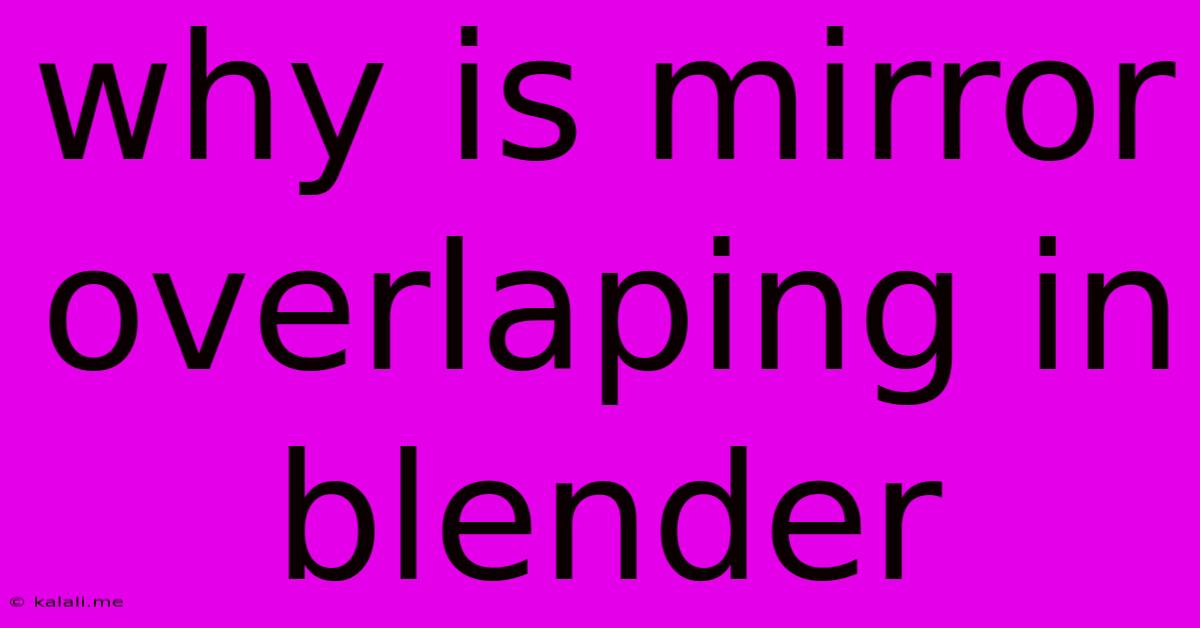Why Is Mirror Overlaping In Blender
Kalali
May 23, 2025 · 4 min read

Table of Contents
Why is My Mirror Modifier Overlapping in Blender? Troubleshooting Common Issues
So, you're using Blender's powerful Mirror Modifier to create symmetrical models, but something's gone wrong. Your mirrored geometry is overlapping, creating a messy, unusable mesh. Don't worry, this is a common problem with a few straightforward solutions. This article will delve into the most frequent causes of mirror modifier overlap in Blender and provide clear, actionable steps to fix them. We'll cover everything from simple origin point adjustments to more advanced techniques, helping you achieve perfectly symmetrical models.
Understanding the Mirror Modifier
Before we troubleshoot, let's briefly recap how the Mirror Modifier works. This modifier duplicates geometry across a specified plane, usually the X, Y, or Z axis. It's incredibly useful for creating symmetrical objects like characters, vehicles, and environments. However, if not set up correctly, it can lead to the overlapping issue you're experiencing.
Common Causes of Mirror Modifier Overlap and Their Solutions:
Here are the most frequent reasons why your mirrored geometry is overlapping, along with practical solutions:
1. Incorrect Origin Point:
- The Problem: The object's origin point (the central pivot point) is not located precisely on the mirroring plane. This is the most common cause of overlap. When the origin isn't on the plane, the modifier mirrors from the wrong center, leading to offsets.
- The Solution: Select your object. Go to Object Mode, then press Shift + S and choose Cursor to Selected. This moves the 3D cursor to the object's center. Next, press Shift + S again and select Origin to 3D Cursor. This aligns the origin point to the cursor, resolving the overlap issue in most cases. Remember to check the mirror axis in your modifier settings (usually X for left-right symmetry).
2. Clipping Issues:
- The Problem: If you have geometry that extends beyond the mirroring plane, the mirrored halves may overlap or intersect. This is particularly noticeable with complex models or when using a modifier stack.
- The Solution: Carefully examine your mesh in Edit Mode. Adjust the geometry so it sits perfectly on or slightly behind the mirroring plane. You might need to use tools like Scale, Grab, or Extrude to reposition vertices or edges.
3. Modifier Stack Order:
- The Problem: The order of modifiers in your stack can influence how they interact. If the Mirror Modifier is placed after other geometry-altering modifiers (like Subdivision Surface or Bevel), it might mirror the already modified geometry leading to overlap.
- The Solution: Experiment with rearranging your modifier stack. Generally, it's best to place the Mirror Modifier as early as possible in the stack. This ensures that the mirroring happens before any other transformations are applied.
4. Merge Option in the Mirror Modifier:
- The Problem: The "Merge" option within the Mirror Modifier combines the original and mirrored geometry. If improperly used, it might result in overlapping vertices or faces.
- The Solution: Disable the Merge option (uncheck the box). Then carefully check and clean up any overlapping vertices or faces manually in Edit Mode. Consider using the Merge by Distance function to quickly resolve close vertices after disabling the Merge option.
5. Incorrect Mirroring Axis:
- The Problem: You might have accidentally selected the wrong axis for mirroring. If you're aiming for left-right symmetry, the X-axis should be selected. Choosing the wrong axis will mirror across an unintended plane, resulting in misalignment and overlap.
- The Solution: Double-check your Mirror Modifier settings and ensure you have selected the correct mirroring axis based on your model's orientation and desired symmetry.
Advanced Troubleshooting:
If you've tried all the above steps and still encounter overlap, consider these:
- Simplify your model: Break down complex models into simpler parts. Mirror each part separately and then combine them.
- Check for hidden geometry: There might be hidden geometry causing collisions, even if it's not immediately visible. Use Blender's X-Ray view mode (found in the Viewport Overlays menu) to check for hidden elements.
- Use Boolean modifiers: Boolean modifiers can help clean up overlapping geometry precisely and effectively. Carefully create a Boolean difference operation between the original and mirrored geometry to remove the overlapping area.
- Re-model: If none of the above solutions work, carefully assessing your model's topology might reveal an underlying modeling issue that requires restructuring. A more organized and logical mesh makes applying modifiers much easier.
By systematically checking these points, you should be able to resolve the overlapping issue and create clean, symmetrical models in Blender. Remember to save your work frequently!
Latest Posts
Latest Posts
-
What Voltage Is A Car Battery
May 24, 2025
-
How To Stop Birds Flying Into Windows
May 24, 2025
-
Do 2 Trades Per Month On F1 Visa
May 24, 2025
-
Why Is My Smoke Detector Chirping
May 24, 2025
-
Why Did Jacob Wrestle With God
May 24, 2025
Related Post
Thank you for visiting our website which covers about Why Is Mirror Overlaping In Blender . We hope the information provided has been useful to you. Feel free to contact us if you have any questions or need further assistance. See you next time and don't miss to bookmark.